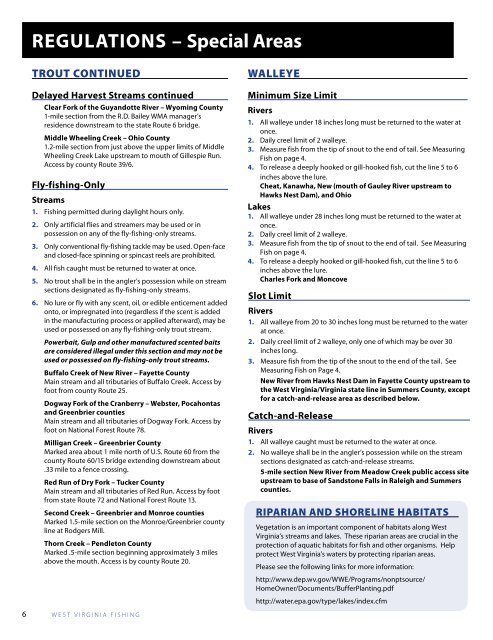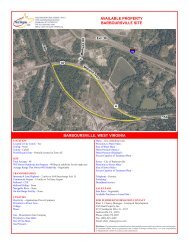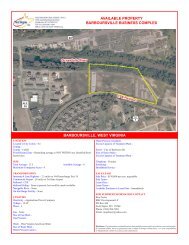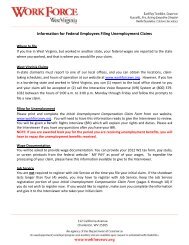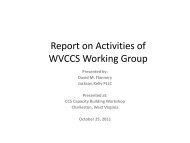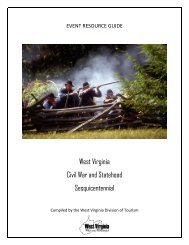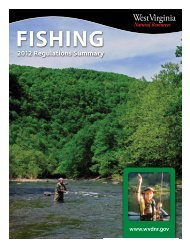Fishing Regulations - West Virginia Department of Commerce
Fishing Regulations - West Virginia Department of Commerce
Fishing Regulations - West Virginia Department of Commerce
You also want an ePaper? Increase the reach of your titles
YUMPU automatically turns print PDFs into web optimized ePapers that Google loves.
REGULATIONS – Special Areas<br />
TROUT continued<br />
Delayed Harvest Streams continued<br />
Clear Fork <strong>of</strong> the Guyandotte River – Wyoming County<br />
1-mile section from the R.D. Bailey WMA manager’s<br />
residence downstream to the state Route 6 bridge.<br />
Middle Wheeling Creek – Ohio County<br />
1.2-mile section from just above the upper limits <strong>of</strong> Middle<br />
Wheeling Creek Lake upstream to mouth <strong>of</strong> Gillespie Run.<br />
Access by county Route 39/6.<br />
Fly-fishing-Only<br />
Streams<br />
1. <strong>Fishing</strong> permitted during daylight hours only.<br />
2. Only artificial flies and streamers may be used or in<br />
possession on any <strong>of</strong> the fly-fishing-only streams.<br />
3. Only conventional fly-fishing tackle may be used. Open-face<br />
and closed-face spinning or spincast reels are prohibited.<br />
4. All fish caught must be returned to water at once.<br />
5. No trout shall be in the angler’s possession while on stream<br />
sections designated as fly-fishing-only streams.<br />
6. No lure or fly with any scent, oil, or edible enticement added<br />
onto, or impregnated into (regardless if the scent is added<br />
in the manufacturing process or applied afterward), may be<br />
used or possessed on any fly-fishing-only trout stream.<br />
Powerbait, Gulp and other manufactured scented baits<br />
are considered illegal under this section and may not be<br />
used or possessed on fly-fishing-only trout streams.<br />
Buffalo Creek <strong>of</strong> New River – Fayette County<br />
Main stream and all tributaries <strong>of</strong> Buffalo Creek. Access by<br />
foot from county Route 25.<br />
Dogway Fork <strong>of</strong> the Cranberry – Webster, Pocahontas<br />
and Greenbrier counties<br />
Main stream and all tributaries <strong>of</strong> Dogway Fork. Access by<br />
foot on National Forest Route 78.<br />
Milligan Creek – Greenbrier County<br />
Marked area about 1 mile north <strong>of</strong> U.S. Route 60 from the<br />
county Route 60/15 bridge extending downstream about<br />
.33 mile to a fence crossing.<br />
Red Run <strong>of</strong> Dry Fork – Tucker County<br />
Main stream and all tributaries <strong>of</strong> Red Run. Access by foot<br />
from state Route 72 and National Forest Route 13.<br />
Second Creek – Greenbrier and Monroe counties<br />
Marked 1.5-mile section on the Monroe/Greenbrier county<br />
line at Rodgers Mill.<br />
Thorn Creek – Pendleton County<br />
Marked .5-mile section beginning approximately 3 miles<br />
above the mouth. Access is by county Route 20.<br />
WALLEYE<br />
Minimum Size Limit<br />
Rivers<br />
1. All walleye under 18 inches long must be returned to the water at<br />
once.<br />
2. Daily creel limit <strong>of</strong> 2 walleye.<br />
3. Measure fish from the tip <strong>of</strong> snout to the end <strong>of</strong> tail. See Measuring<br />
Fish on page 4.<br />
4. To release a deeply hooked or gill-hooked fish, cut the line 5 to 6<br />
inches above the lure.<br />
Cheat, Kanawha, New (mouth <strong>of</strong> Gauley River upstream to<br />
Hawks Nest Dam), and Ohio<br />
Lakes<br />
1. All walleye under 28 inches long must be returned to the water at<br />
once.<br />
2. Daily creel limit <strong>of</strong> 2 walleye.<br />
3. Measure fish from the tip <strong>of</strong> snout to the end <strong>of</strong> tail. See Measuring<br />
Fish on page 4.<br />
4. To release a deeply hooked or gill-hooked fish, cut the line 5 to 6<br />
inches above the lure.<br />
Charles Fork and Moncove<br />
Slot Limit<br />
Rivers<br />
1. All walleye from 20 to 30 inches long must be returned to the water<br />
at once.<br />
2. Daily creel limit <strong>of</strong> 2 walleye, only one <strong>of</strong> which may be over 30<br />
inches long.<br />
3. Measure fish from the tip <strong>of</strong> the snout to the end <strong>of</strong> the tail. See<br />
Measuring Fish on Page 4.<br />
New River from Hawks Nest Dam in Fayette County upstream to<br />
the <strong>West</strong> <strong>Virginia</strong>/<strong>Virginia</strong> state line in Summers County, except<br />
for a catch-and-release area as described below.<br />
Catch-and-Release<br />
Rivers<br />
1. All walleye caught must be returned to the water at once.<br />
2. No walleye shall be in the angler’s possession while on the stream<br />
sections designated as catch-and-release streams.<br />
5-mile section New River from Meadow Creek public access site<br />
upstream to base <strong>of</strong> Sandstone Falls in Raleigh and Summers<br />
counties.<br />
Riparian and Shoreline Habitats<br />
Vegetation is an important component <strong>of</strong> habitats along <strong>West</strong><br />
<strong>Virginia</strong>’s streams and lakes. These riparian areas are crucial in the<br />
protection <strong>of</strong> aquatic habitats for fish and other organisms. Help<br />
protect <strong>West</strong> <strong>Virginia</strong>’s waters by protecting riparian areas.<br />
Please see the following links for more information:<br />
http://www.dep.wv.gov/WWE/Programs/nonptsource/<br />
HomeOwner/Documents/BufferPlanting.pdf<br />
http://water.epa.gov/type/lakes/index.cfm<br />
6 W E S T V I R G I N I A F I S H I N G


